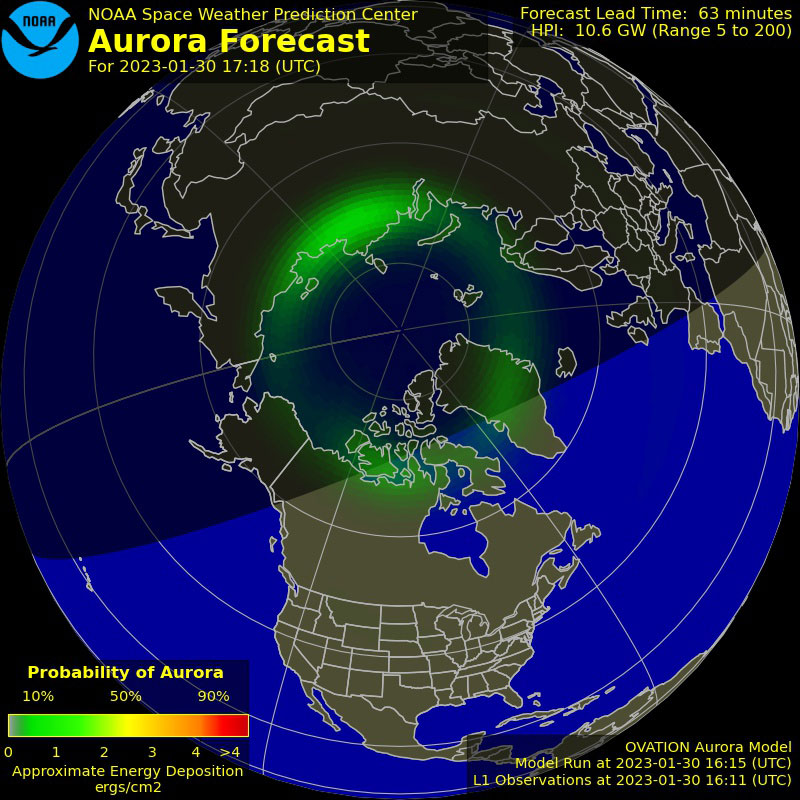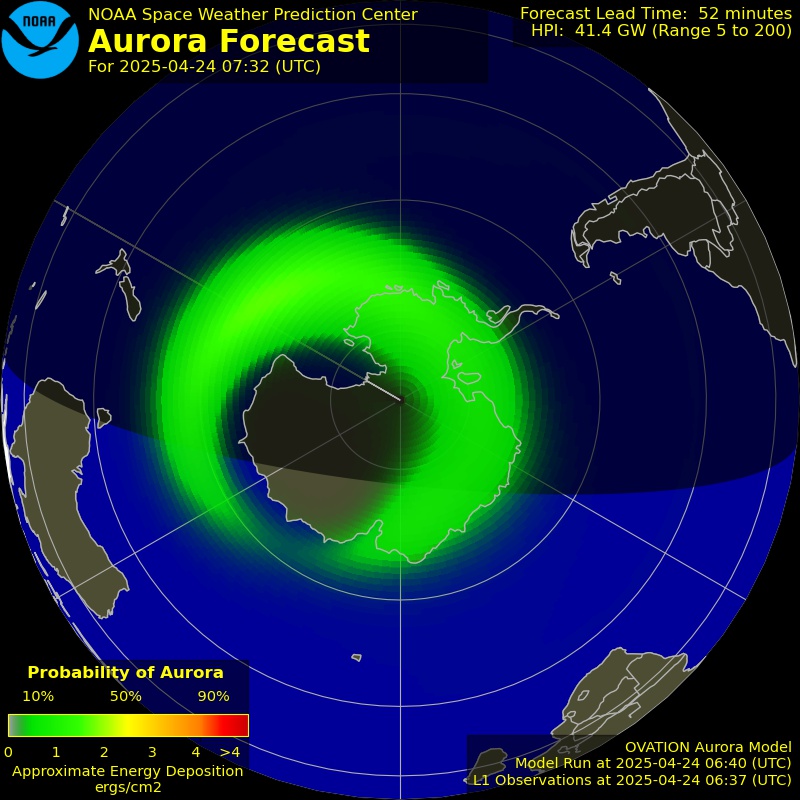Aurora Forecast NOAA: Your Ultimate Guide To Chasing The Northern Lights
Have you ever dreamed of witnessing the breathtaking dance of the aurora borealis? Well, thanks to the NOAA aurora forecast, your dream might just become a reality sooner than you think. The National Oceanic and Atmospheric Administration (NOAA) has been working tirelessly to provide accurate aurora forecasts so you don’t miss out on this once-in-a-lifetime experience. Whether you’re a seasoned aurora chaser or just someone who loves gazing at the stars, this guide is about to change your game.
Let’s be real here—chasing the northern lights isn’t as simple as packing your bags and heading north. You need the right tools, the right conditions, and most importantly, the right forecast. That’s where NOAA comes in. Their aurora forecast is like your personal weatherman for the skies, helping you plan your trip with precision.
But hey, before we dive deep into the nitty-gritty of aurora forecasts, let’s talk about why this matters. Imagine standing under a sky painted with vibrant greens, purples, and pinks. It’s not just a sight—it’s an experience that stays with you forever. And trust me, having the NOAA aurora forecast in your corner makes all the difference.
Read also:Remote Access For Raspberry Pi And Iot Devices Free Download Your Ultimate Guide
Table of Contents
- What is Aurora?
- NOAA Aurora Forecast Explained
- How Does the Aurora Forecast Work?
- Tools You Need for Aurora Hunting
- Best Locations for Aurora Viewing
- Aurora Season: When to Go?
- Reading the Aurora Forecast Like a Pro
- Common Mistakes to Avoid
- The Science Behind Aurora
- Final Thoughts
What is Aurora?
Auroras, also known as the northern lights (aurora borealis) or southern lights (aurora australis), are nature’s ultimate light show. But what exactly are they? Simply put, auroras occur when charged particles from the sun collide with Earth’s atmosphere, creating dazzling displays of light. Think of it like the universe throwing a massive party in the sky—and you’re invited!
These natural wonders aren’t just random occurrences. They’re closely tied to solar activity, which is why forecasting them is both an art and a science. And speaking of science, that’s where NOAA steps in. Their aurora forecast helps us predict when and where these magical events will happen.
Why Are Auroras So Fascinating?
Here’s the thing about auroras—they’re not just pretty lights. They’re a glimpse into the cosmic dance between our planet and the sun. Every time you see an aurora, you’re witnessing a live demonstration of how our atmosphere protects us from the sun’s energy. It’s kinda like watching a superhero movie, except the hero is Earth’s magnetic field.
NOAA Aurora Forecast Explained
So, what’s the deal with the NOAA aurora forecast? Basically, it’s a tool designed to help you plan your aurora adventures. NOAA uses advanced satellites and ground-based instruments to monitor solar activity and predict geomagnetic storms. These storms are what cause auroras, so knowing when they’re happening is key to catching the show.
The forecast provides a 3-day outlook, along with real-time updates. This means you can plan your trip days in advance and still have the flexibility to adjust based on current conditions. Pretty cool, right?
What Does the NOAA Aurora Forecast Include?
Here’s a quick rundown of what you’ll find in the NOAA aurora forecast:
Read also:William Fichtner The Unsung Hollywood Gem You Need To Know
- Kp Index: A scale from 0 to 9 that measures geomagnetic activity. Higher numbers mean better chances of seeing auroras.
- Predicted Activity: A map showing where auroras are most likely to occur.
- Real-Time Data: Updates on current solar wind conditions.
How Does the Aurora Forecast Work?
Alright, let’s get nerdy for a second. The NOAA aurora forecast works by tracking solar flares and coronal mass ejections (CMEs). When the sun burps out a bunch of charged particles, they travel through space and eventually reach Earth. If they hit our magnetic field just right, voilà—you’ve got auroras.
NOAA uses a network of satellites and ground stations to monitor these events. They analyze the data and create forecasts that tell you when and where auroras are likely to appear. It’s like having a crystal ball for the skies, but way more accurate.
Breaking Down the Kp Index
The Kp index is basically the aurora forecast’s grading system. Here’s how it works:
- Kp 0-2: Boring skies. Keep dreaming.
- Kp 3-4: Aurora sightings possible in polar regions.
- Kp 5-6: Auroras visible in northern parts of the U.S. and Europe.
- Kp 7-9: Epic displays visible as far south as Texas and northern Italy.
Tools You Need for Aurora Hunting
Now that you know how the NOAA aurora forecast works, let’s talk gear. Aurora hunting isn’t just about showing up and hoping for the best. You’ll need some tools to make the most of your experience.
Camera: A good DSLR or mirrorless camera is a must if you want to capture the auroras. Look for one with manual settings so you can adjust exposure and ISO.
Tripod: Stability is key when shooting long exposures. A sturdy tripod will keep your shots sharp and steady.
Warm Clothes: Let’s be real—auroras happen in cold places. Dress in layers and bring hand warmers to keep your fingers from freezing.
Apps to Help You Chase the Lights
There are plenty of apps out there to help you with aurora hunting. Some of the best ones include:
- Aurora Alerts
- My Aurora Forecast
- Aurora Service
Best Locations for Aurora Viewing
So, where should you go to see the auroras? Well, it depends on the Kp index and your travel budget. But here are some top spots to consider:
Iceland: With its stunning landscapes and minimal light pollution, Iceland is a dream destination for aurora hunters.
Alaska: The Last Frontier offers some of the best aurora viewing in the world, especially in places like Fairbanks.
Norway: The Lofoten Islands and Tromsø are prime locations for catching the northern lights.
Tips for Finding the Perfect Spot
When choosing a location, look for places with:
- Low light pollution
- Clear skies
- Easy access to dark areas
Aurora Season: When to Go?
Timing is everything when it comes to aurora hunting. The best time to see the northern lights is during the winter months, typically from September to April. This is when the nights are longest and the skies are darkest, giving you the best chances of spotting auroras.
But here’s the kicker—the auroras can happen year-round. It’s just that the summer months in the polar regions have too much daylight to see them clearly.
Peak Aurora Activity
If you’re looking for the best odds, aim for the equinoxes—around March and September. These periods tend to have higher geomagnetic activity, meaning more intense auroras.
Reading the Aurora Forecast Like a Pro
Alright, let’s talk skills. Reading the NOAA aurora forecast might seem intimidating at first, but with a little practice, you’ll be a pro in no time. Here’s what you need to know:
Start with the Kp Index: Check the predicted Kp value for your location. If it’s above 5, get ready for a show!
Look at the Maps: NOAA provides maps showing auroral oval predictions. These show where auroras are most likely to occur.
Check Real-Time Data: Keep an eye on the solar wind speed and density. Higher values mean better chances of auroras.
Pro Tips for Forecasting
Here are a few tips to help you master the aurora forecast:
- Sign up for email alerts to get notifications when auroras are predicted.
- Follow aurora-chasing groups on social media for real-time updates.
- Use multiple sources to cross-check forecasts for accuracy.
Common Mistakes to Avoid
Even the best aurora hunters make mistakes. Here are a few to watch out for:
Ignoring the Forecast: Don’t just show up hoping for the best. Use the NOAA aurora forecast to plan your trip.
Not Dressing Warmly Enough: Trust me, you don’t want to be that guy shivering in the snow.
Forgetting Your Gear: Double-check your camera, tripod, and extra batteries before heading out.
How to Avoid These Pitfalls
Here’s how to stay ahead of the game:
- Create a checklist for your gear and supplies.
- Study the forecast carefully and adjust your plans accordingly.
- Bring snacks and warm drinks to keep your energy up during long nights.
The Science Behind Aurora
Let’s dive a little deeper into the science of auroras. As we mentioned earlier, auroras are caused by charged particles from the sun interacting with Earth’s magnetic field. But what exactly happens during this process?
When these particles hit our atmosphere, they collide with oxygen and nitrogen molecules. These collisions excite the molecules, causing them to emit light. The color of the aurora depends on the type of molecule and the altitude at which the collision occurs.
Why Do Auroras Have Different Colors?
Here’s the breakdown:
- Green: Most common color, caused by oxygen molecules at lower altitudes.
- Red: Rare color, caused by oxygen molecules at higher altitudes.
- Purple/Pink: Caused by nitrogen molecules.
Final Thoughts
Chasing the northern lights is an adventure like no other. With the help of the NOAA aurora forecast, you can increase your chances of witnessing this natural wonder. Remember to plan ahead, bring the right gear, and most importantly, enjoy the experience.
So, what are you waiting for? Grab your camera, pack your warmest clothes, and head out to see the auroras. And don’t forget to share your photos with us—we’d love to see your adventures!
Until next time, happy hunting!
Article Recommendations


